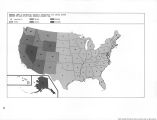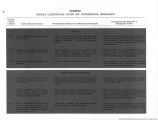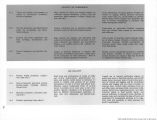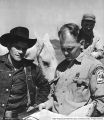| OCR Text |
Show The Federal agencies do not now have positive policies for conducting any effort in localities to make rules of use known to other users, or for arranging to see that the rules are understood and complied with. Congressional action should supply ground rules of use, together with the necessary authority for use regulation. Pricing Recommendation 44: Fair market value, taking into consideration factors in each area of the lands involved, should be established by law as a basis for grazing fees. Prior to 1905, as stated earlier, no charge was levied for livestock grazing on any of the public domain. After that, by administrative action, permits were required and fees levied for grazing on the national forests. These fees, were nominal for many years, but in 1931 a scale of fees was established for each area, based upon charges for private lands adjusted for differing conditions. The fees were adjusted annually to reflect changes in beef cattle and lamb prices, and the system was applied through 1968. Grazing on the unreserved public domain under the jurisdiction of the Department of the Interior continued free of charge until enactment of the Taylor Grazing Act which gave the Secretary authority to charge a "reasonable fee in each case to be fixed or determined from time to time." 15 In administering the Taylor Act during its early years, grazing fees were not related to cost of administration. In 1947 the Act was amended to provide that in determining "reasonable" fees the Secretary must take into account the extent to which grazing districts yield public benefits over and above those accruing to the users of the forage resources for livestock purposes. Also, the Act provided that "such fees shall consist of a grazing fee for the use of the range, and a range improvement fee." 16 It is clear that Congress assumed that the administrative costs would be used as a yardstick in fixing fees, and that the 1947 amendment to the Taylor Act was designed to assure that administrative costs were properly allocated between grazing and other purposes of the Taylor Act. In administering the Taylor Grazing Act, the Department of the Interior has not interpreted the Act to be a revenue producing measure. This interpretation, which finds support in the legislative history of the Act, has been reflected in level of fee receipts. From 1947 to 1957, fees charged by the 1543U.S.C. § 315b (1964). 16 Act of August 6, 1947, 61 Stat. 790. Bureau of Land Management increased from 5 cents per animal unit month to 15 cents by negotiation with the industry. Beginning in 1958 and continuing through 1968, fees were set in relation to the previous year's livestock prices. In 1968 the fee was 33 cents per animal unit month. A study of user charges released by the Bureau of the Budget in 1964, recommended that an inter-agency group develop a uniform system for establishing grazing fees based on the economic value of the forage to the user. The group submitted a report in 1967 recommending a fee system which was adopted by the Forest Service and Bureau of Land Management in 1969. The system adopted provides for increasing grazing fees over a period of 10 years by annual increments to $1.23 per AUM.17 Over the years, attempts to establish fees for public land grazing have been fraught with confusion. The statutory mandate that fees be "reasonable," qualified by a direction to take into account "the extent to which districts yield public benefits over and above those accruing to the users" is largely responsible for this confusion. Obviously, what might be considered as reasonable to non-users, may well seem unreasonable to grazing permittees. While some public benefits may be identified, they are not easily quantified, i.e., translated into specific monetary terms. Furthermore, not all of these benefits are common to all grazing areas. A proper statutory basis for grazing fees on land retained in Federal ownership would be "fair market value" and the Commission recommends the adoption of this standard. Fair market value, however, is only valid as a standard if it provides a measure of the value of what is sold to the purchaser who knowingly takes into account the advantages and disadvantages of product or services. Fair market value for public land grazing is not necessarily the same as the value of private grazing land. It is the price which would be paid for public land grazing, given all of the advantages and disadvantages of grazing domestic livestock on the public lands. It is the value that ordinarily would be established by operation of the open market. Application of a "fair market" value standard to grazing fees would protect the interest of the public as landlord. Equity to the users, however requires consideration of some qualifying factors in determining fair market values. 17 Commission staff, User Fees and Charges for Public Lands and Resources, Ch. IV. PLLRC Study Report, 1970. This report provides a detailed description of the procedures followed in establishing the new fee system. Implementation of the system announced in 1969 has been suspended for a period of 1 year pending the receipt of this Commission's report. 117 |







































































































































































































































































































































































